|
|
This page is
graphically intense
with long load times due to photos. However, the photos and narratives by the
men who served at Camp Echo Hill makes the wait well worthwhile.
HOW IT WAS!
CAMP ECHO HILL
KIMJE, SOUTH KOREA

E/4/44 (Feb 1961-Sep 1972)
E/2/44 (Sep 1972-1976)
|

| NOTE: This unit's history was first created as a subsection in the "Kunsan AB: How It Was..." site, but it soon become apparent that this unit was a separate entity with no ties to Kunsan AB except that it was supported by the Kunsan (K-8) for food and medical supplies. Therefore, a separate site was created for this unit which will be linked to from the Kunsan AB site. |

This guest book is for ALL Camp Echo Hill visitors...whoever you are.
We welcome all comments.
However, if you're an vet from Camp Echo Hill,
please leave your email address
so other Camp Echo Hill vets can find you...

11th Armored Cav Regiment
C Troop 2nd Platoon
Danny Weasenforth (NR)
|
 Fort Huachuca ACS Fort Huachuca ACS
Award of Excellence (NR) |
Some of the awards this site has received. To view our awards, go to Awards.
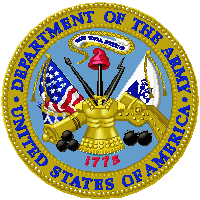

U.S. Army Nike unit at Kimje (Camp Echo Hill):
Acknowledgement: Grateful thanks to Kenneth Wisz of Lackawanna, New York for his maps, narratives and detailed descriptions of life at Camp Echo Hill. Without his aid, we would never have found our way to the site.
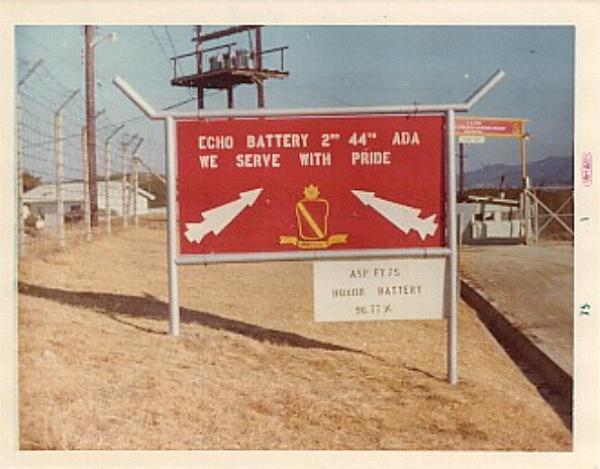
E-Battery Sign |
Kenneth Wisz wrote, "E/2/44 (Echo Battery/2nd Battalion/44th Air Defense Artillery) was the southernmost of the US Army's 6 Nike sites strung out along the west coast of Korea. We were under the operational control of the Air Force HQ at Osan AB." Thus the unit was not formerly in the Kunsan AB organizational chain but only relied on it for supplies. He wrote, "We were the only Nike battery that got most of our logistical support from Kunsan -- food, medical, px , pojee, etc. The others got theirs from Camp Humphreys up at Pyongtaek."

Location of Nike sites
By George Carmack
Kenneth Wisz wrote, "On the map I'm attaching you'll see b/4/44 which was b/2/44 when I was in Korea. It was known as sea (special eighth army) range. That is where the annual service practices were held every summer with live Nike and Hawk firings at drones flown over the Yellow Sea at Daechon (Taechon) beach."
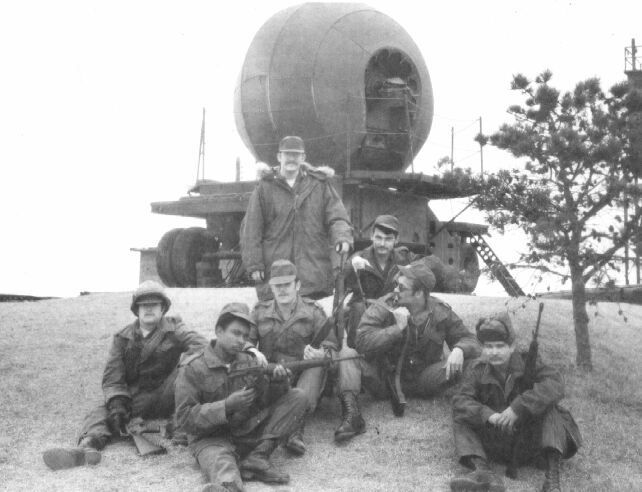
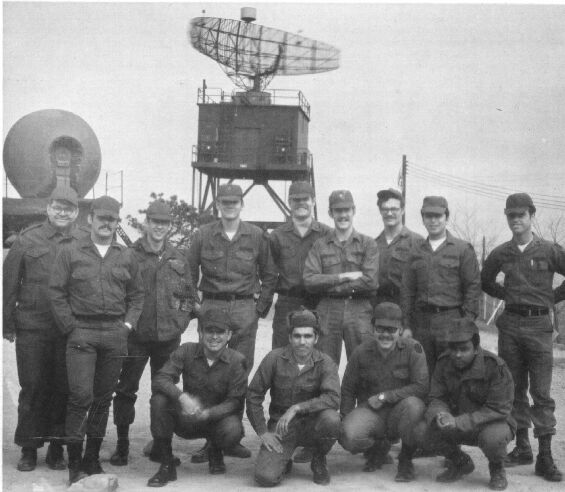
IFC at SEA in Taechon (Jake Jegelewicz -- Nike People)
Jake "The Snake" Jegelewicz wrote, "... an those were pics of some of my guys at Sea Range. I ran the AN/MPQ T-1 for the Nike firings. Also have a site on Military.com for Nike people. Was there in 71-72 an got more pics if ya need any."
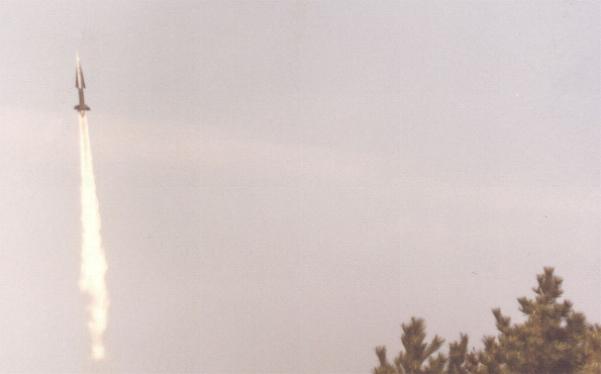 Last firing at the SEA range in 1978
Last firing at the SEA range in 1978
Click on image to Enlarge
Photo by David Hansman
Unit History: Kenneth wrote a little about the unit history, "e/2/44 was originally e/4/44 and arrived in Korea on Feb 26, 1961. It got it's "special weapons capability" (nukes) in April 1962. The basic Nike system was exchange for the improved system in June 1967. On Sept 13, 1972 e/4/44 was redesignated e/2/44. I believe it was turned over to the ROK Army in 1976." Camp Echo Hill was turned over to the ROK Army with equipment in place on April 1977.

38th Brigade Patch: Hand of Power
According to Kenneth Wisz, "it was better known as 'the fist of shit'."
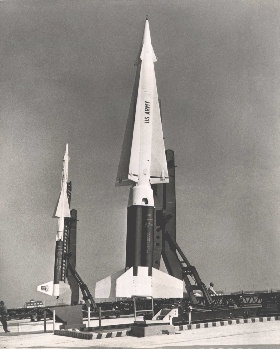
Nike Hercules Missile
E/4/44 (Feb 1961-Sep 1972)
1961 C.A. Zeitler of Portland, OR wrote in the guest book in Feb 2003, " I have a lot of photos from my time in Korea. I even have a photo of the original firing of the Hercules in August 1961. Inspite of what the front page said... we actually arrived there in Dec 1960 and we were operational by April 1961."
1962 Wilmer (Bill) Lowe of Rochester, NY wrote in the guest book in Dec 2005, "And now, one of the OLD guys from Echo Hill. I was there from approximately September of 1962 through October of 1963. My specialty was acq operator but I also did quite a bit of supply driving to Taejon and other points and, for a while, was parts clerk for the IFC Hill. Had a warrant officer who insisted we keep a full foot locker of tubes over and above what we were authorized for spares. Had to send that damn thing out on a truck everytime we had an inspection from headquarters. Was on site during the Cuban Missle Crisis. Pretty tense couple of weeks wondering whether there was more to it than the missle build up on that island. Great times are just about all I remember from back then...20 year old kid from the Pennsylvania farm country in a foreign country! Who'd a thunk it? Anybody know the where abouts of Jim Goff, Frank Holbrook, Ted Orwig, Mike Lasko or anyone else from that era at Camp Echo Hill? And, by the way, kudos and a heartfelt thank you to the creator of this site. What a trip down shit-scented memory lane!!!"
1963 Dino DiMarco wrote, "I was the EMMC, Maintenance Chief/Assembly Sgt. MOS 223.6, SFC E-7, for E-4-44 from Jan. 63 to Feb. 64. ... I have pictures of annual service practice on the beach of the Yellow Sea."
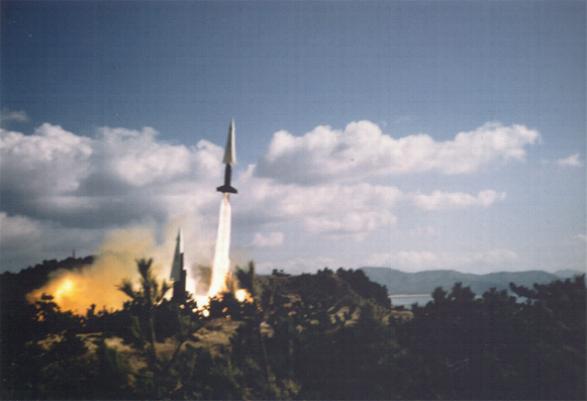
Hercules on the Move at Sea Range
Click on photo to enlarge
(Courtesy Bob Semple)

Missile Away at Sea Range
Click on photo to enlarge
(Courtesy Bob Semple)
1964 Philip B. Davis of Spotswood, NJ wrote in the guestbook in May 2004, "I was stationed at Camp Echo Hill for 13 months, February 1965 through March 1966. I was one of seven sentry dog handlers. My dogs name was Prince. I remember a really bad dust storm. It covered the snow on the ground with a reddish brown layer of dust. They called it a Monglian Dust Storm." (SITE NOTE: The storms continue every year and is currently called the "Yellow Storm" because of the yellowish dust that settles on everything and causing respiratory problems throughout the northwestern portions of Korea.)
1965Robert S Semple of Palo Alto, CA wrote in the guestbook in Nov 2001, "In late 12/64, as a brand new 2LT out of Ft. Bliss, I was initially the Launcher & Security Platoons Leader; then later "promoted" to XO until rotation in 1/66. Fellow 2LT Ken Turner, who came down to Echo and rotated out with me, and I were known as "3-year men" since our 13-month tour included parts of 3 years which also means we "experienced" (froze our buttocks & other parts) more of the winter months than anyone else.
"I claimed what was then the Battery record for lasting the longest from day of arrival until contracting diarrhea: 30 days (O think)! My antidote was "Pinch" scotch. Unfortunately, my record ended when I was the "BCO-in-the-barrel" early in the AM while trying to sleep in the IFC ready hut on hot status. I was in so much pain, that I cried out for the IFC sgt. to call the NCO hooch for the medic and the BOQ so that I could be immediately relieved. The medic came first and had me carried off the rack into his 3/4 as I couldn't stand or even sit. We immediately left the hill even though my relief (maybe that rascal Ken Turner?) hadn't come up yet as the initial response from the BOQ was to challenge whether I was pulling a joke. So, for a period of maybe 5 minutes, the skies over South Korea were undefended by a 2LT BCO. This, of course, was never reported to nor ever found out by 4/44 or 38th Bde.:
"Jerry Greely, 1LT, RA (but not "all the way"), Airborne, whom you read about on the website and in this guestbook was the second of my 3 BCs. Jerry wanted all of his officers to qualify Airborne and had each of us jump off the top of the water tower in the admin. area holding a sheet over our head yelling "Geronimo", except we never got to the "mo" part. (Hi Jerry...ha, ha!) ..."
Bob Semple continued later, "By way of background, Jerry Greely 1LT (RA) was the CO for about 5 months over the
"balmy" summer months of 1965. I, 2LT (ROTC), was initially the Launcher &
Security Platoons Leader from Jan65 to Sept65, then XO until rotation in
Feb66."
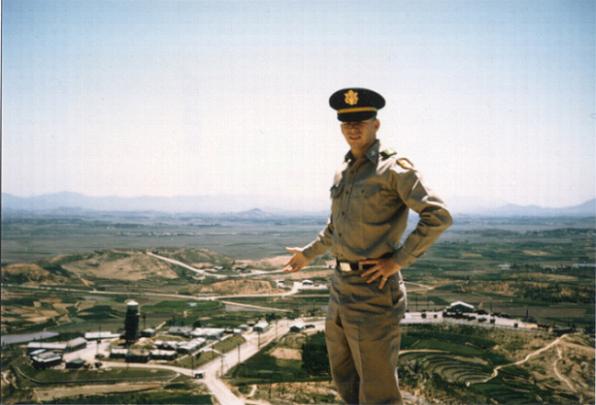
Bob Semple - XO Showing Off Camp Echo
(Courtesy Bob Semple)
"The IFC hill was totally denuded of trees and virtually all vegetation. Its
access road was an extension of the road that initially went straight up the
"admin hill" to the main gate of the Administrative area. The admin area
had been flattened and tiered to accommodate all of the Battery's admin
buildings, including motor pool (stuck out on a point immediately to the
left of the main gate), all living quarters, mess hall, theatre, & water tower."
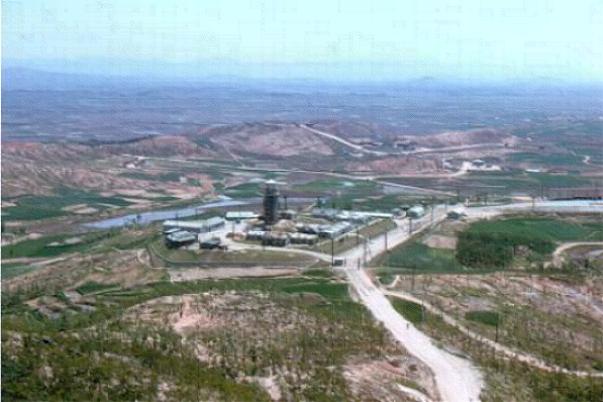
View of Admin area from IFC
Looking South-southeast (1965)
(Click on photo to enlarge)
(Courtesy Jerry Greeley)
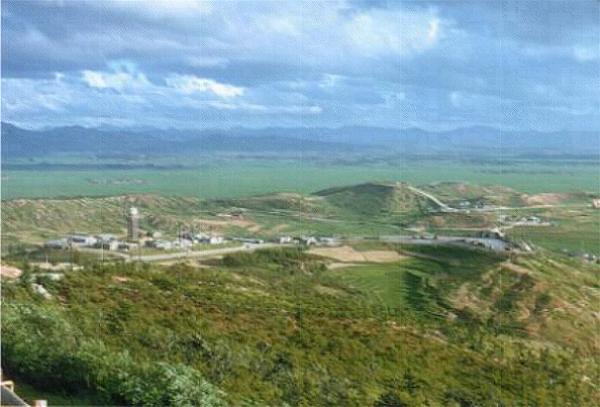
View of Admin area from IFC (1965)
(Click on photo to enlarge)
(Courtesy Jerry Greeley)
(NOTE: Ken Wisz noted that "The large water tower in the admin area was gone
when I was there (1975), replaced by a smaller one by the water treatment plant.")
"Then one would drive straight ahead thru the admin area, across the "parade
ground" where morning formations were held, and out the "back gate" and up
rather steeply to the top of the IFC hill. The road goes fairly straight
up, veering slightly to the left, before suddenly flattening out on the
Battery's only helipad (in 1965) on the top of IFC hill and adjacent to the
gate leading into the IFC area. Overall the top of IFC hill was fairly
small; I recall the two 45 kW diesel generators (for tactical power) were
located just 15 feet from the ready hut where we slept during hot status.
On certain religious occasions, the village elders (I believe) would be
permitted to walk up the admin hill, thru the admin area and up to the
helipad where they would conduct religious observances (I believe) as the
hill had apparent ancient religious significance."
"To go down to the Launcher area, one drove down the admin hill to the Kimje
road, turned left through the village, then, after immediately leaving the
village, turn right onto the short access road that led to the gate leading
into the Launcher area. The guardpost at the Launcher area gate had an
excellent view of all traffic between the Battery's 3 areas (it was
impossible for me to conduct surprise security inspections, even at night,
without that guard either seeing me or getting the word that the "pee
bringer" was on his (my) way). ..."
"Again, from dimming recall, before reaching the Buddhist temple is a road
leading to the left (?) to a rock quarry where we conducted live warhead
destruction drills using shape charges and detonation cord."
"As for the area around the Battery at that time, in 1965, all of the ground
outside the barbed wire fencing of all 3 areas was open, offering excellent
fields of fire, though we were hardly prepared then to conduct any
significant firefight or self-defense of the Battery. There were no US
unit(s) to provide external security. For that, we depended on a battalion
(?) of the ROK 5th Division, HQ'd about 20-25 miles NE of the Battery (...
or so I recall as I went to their HQ only once) to be detached and deployed
around the entire site. They would "practice" this once a year."
"In 1965, the IFC hill had only 3 radars: LOPAR, TTR & MTR. The Battery was
chronically under TOE, from LTs to PFCs. ..."
"Neither Jerry nor I could recall a bridge over railroad tracks going into
Kimje. All the roads to everywhere were unpaved. Vehicles tended to drive
down the middle of the road as it tended to be smoother (emphasis on "er")
which led to some interesting "chicken" encounters." (NOTE: The bridge over the railroad tracks at Kimje Railway Station was probably built in the early 1980s based on the narrow two-lane construction. It passes completely over the multi-track railroad yard below.)
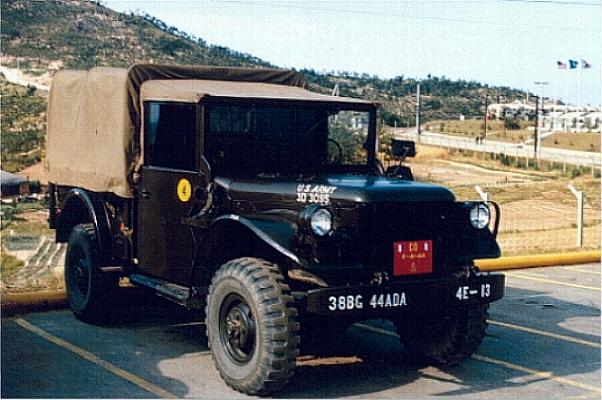
Motor Pool: Spit-shined 3/4 Ton | 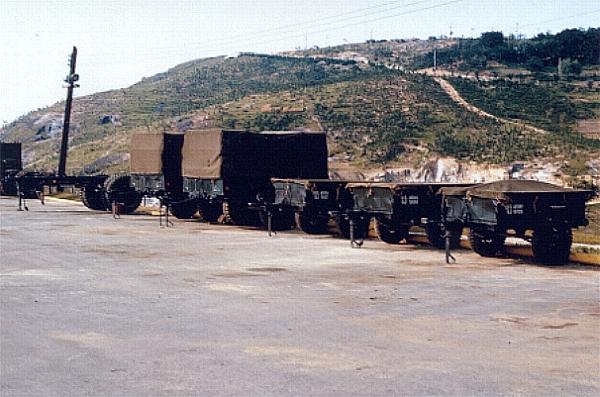
Motor Pool: Convoy Assembled |
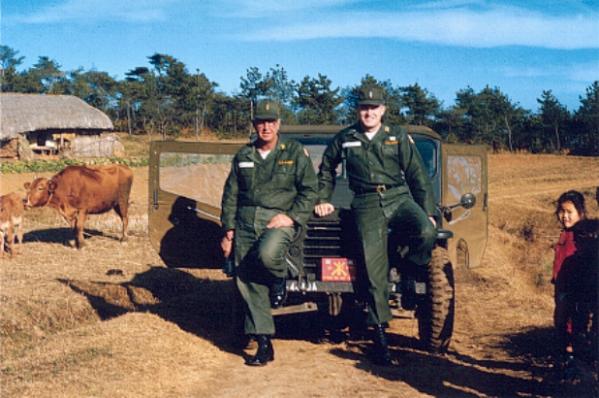
New Battery Commander |
Left: Motor pool with spit shined 3/4 ton and trailers
- Greely chose 3/4T over 1/4T jeep due to rough roads (1965);
Center: Motor Pool; Right: Greely (right)
- XO of C-4-44 on his way to Echo - May 65
Click on thumbnail to enlarge
(Courtesy Jerry Greely)
"Here's one of my stories for you: Needing to go to Kunsan on some matter, I
told the mail run driver that I wanted to drive the 3/4 after we got out of
sight of the Battery (officers were designated passengers)."
"Approaching Kunsan, the road was straight but rocky with a high crown and
about a 5-foot drop-off on either side into rice paddies. Coming in the
opposite direction was a "Kimchi bus". As the distance closed between us,
neither the bus driver nor I wanted to yield the center of the road. At the
last instant, we each veered just enough to pass each other. However, the
bus passed so close that it scrapped off the antenna mount on the 3/4. I
immediately braked, jumped out and picked up the mount and heard the bus
driver shouting a series of curses at me, pointing to the crease that the
antenna mount cut into the side of his bus. I bowed and quickly jumped into
the 3/4 and took off for Kunsan AFB. Returning to the Battery as the
designated passenger (the driver was concerned about the antenna mount since
he had signed out the 3/4), I handed the antenna mount to the motor pool
sergeant reporting that some Air Force truck must have knocked it off the
3/4 where it had been parked. He gave me a strange look, but said nothing.
Power: All tactical power was provided by 45 kW field generators mounted on
trailers (so they could be easily moved for repair and replacement). IFC
had 2 and each of the launcher sections had 1. I believe we had a couple of
spares. We depended on Korean power for all admin. and non-tactical use in
the IFC and Launchers areas. I believe the Signal Detachment, known as
"Salt Lake", had its own generator(s?)."

Wrecker Accident
Click on Photo to Enlarge
(Courtesy Jerry Greely)

First ROK Missilemen Class |
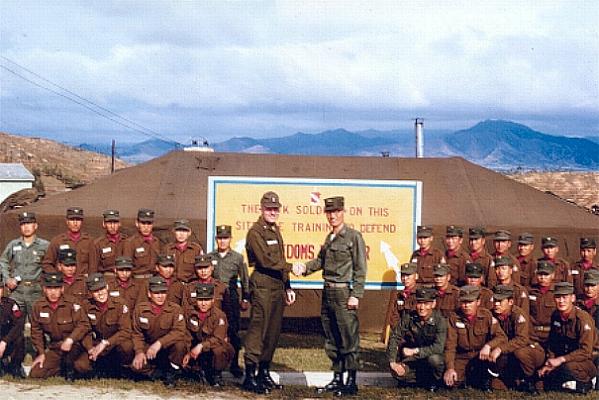
First ROK Missilemen Class |
Lt. Greely and Capt Kim
with the first graduating class
of ROK Nike Herc missilemen (1965)
Click on Thumbnail to Enlarge
(Courtesy Jerry Greely)
The pictures below are typical of village life in a poor country town in the 1960s. The times were very poor. The clothing of the children are patched. Notice the student uniforms for the boys which were the standard black jacket and black cap. If they were lucky, they had a matching coat and pants. Most had hand-me-down coats that were three sizes too small. The characteristic rosy cheeks of the youngsters is from the biting cold -- and not an indication of robustness. Also note the thatched roofed mud-wattle houses in the compounds. The smoke stacks extending upward in the street are for the combination cooking stove and ondol heating system for these type of homes. The picture of the grandfather (haraboji) sitting on the front stoop of a farmers house (Choga Chip) is typical of the times. Note the wooden sliding doors with rice paper to let in light and keep out the cold drafts. Times were hard, but Koreans still smiled for the camera as photos were still not common. During the Korean War, many Koreans destroyed their pictures for fear of another North Korean invasion and fear that any photo might link them unwittingly to others accused of crimes.
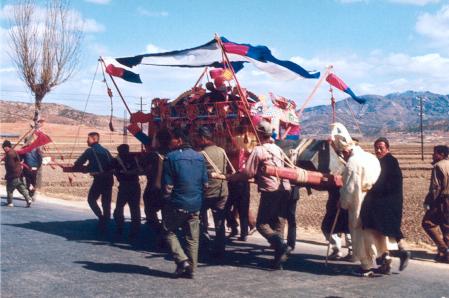
Farmer Funeral |
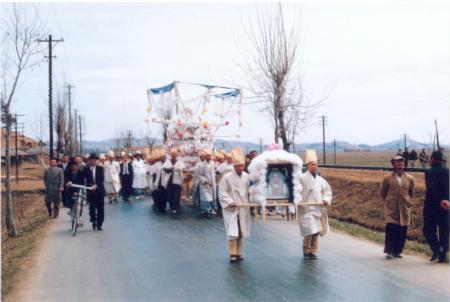
Farmer Funeral |
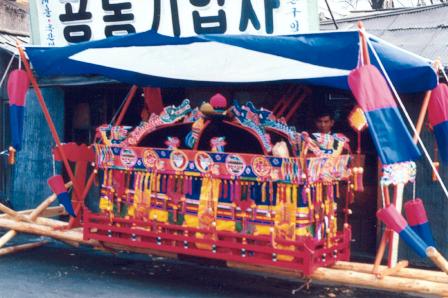
Elaborate Casket |

Village Children |
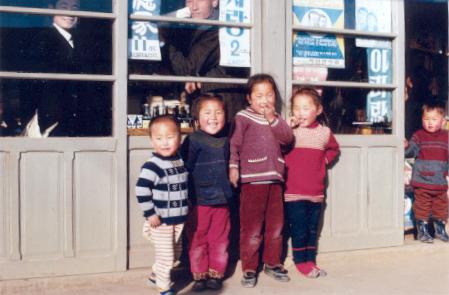
Village Children |
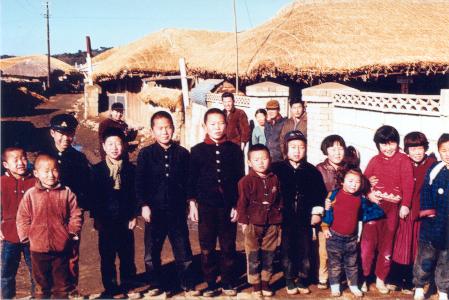
Village Children |
Farmer's Funeral and Village Children
Click on Photo to Enlarge
(Courtesy Jerry Greely)
The pictures of the funeral depict a typical country funeral in the old days. The people preceding the funeral procession are carrying a picture of the deceased. The family wore ramie cloth (hemp) fabric and accompanied the body to the funeral site. The elaborate casket was only for transportation and the body was in a plain wooden box. Often times, messages or mementoes would also be placed in the box with the body. The casket was buried in a shallow grave and a mound built up over the grave. In those days rich families hired "mourners" with gongs and cymbals would wail and cry as they accompanied the procession. Nowadays this type of funeral procession is seldom seen with the ritual procession being substituted with a bus or vans to transport the people from the mortuary to the funeral site. However, the ramie cloth and other trappings are still used. Also with the lack of space nowadays in the cities, the option of cremation has become the preferred method for those without ancestral burial grounds -- hillsides in the country.
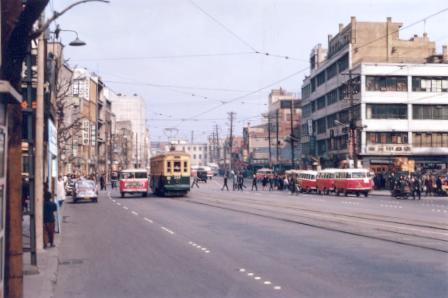
Seoul street |
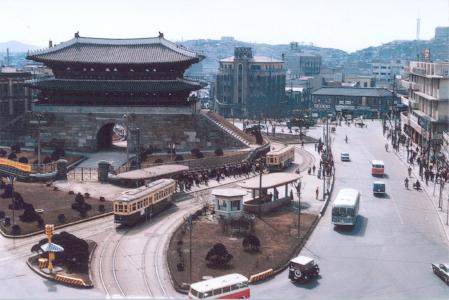
Seoul Main Gate |
Seoul Trip
Click on Photo to Enlarge
(Courtesy Jerry Greely)
Jerry Greely's photos are of a trip to Seoul in the 1960s. To get around Korea there were two modes of transportaton -- the famous kimchi bus or train. Buses and trains were the primary mode of transportation in the country. Only the rich had privately-owned vehicles. Buses were for intra-city traffic and trains for intra-province traffic. In small towns like Kimje or Kunsan, there was no inner-city bus system yet. If a GI was brave enough to catch the Kimchi buses all the way to Seoul, he was one brave soul indeed. On a bus or train packed with Koreans -- especially in winter when the windows would be closed -- the overpowering smell of garlic from the kimchi everyone ate would assault a foreigner's nostrils. Note that in the Seoul street scenes, the electric street cars that were still in operation. These had been around since the Japanese occupation days and were eliminated after more modern forms of air-polluting buses were put on the streets. The picture of Tongdaemun (North Gate) traffic circle is really fascinating. Also notice how the streets are virtually empty of cars. The small building in the foreground near the trams is the stairs from the subway. Also note the absence of privately-owned vehicles. Seoul now is always bumper-to-bumper traffic. The season was fall or early winter as the trees are neatly cropped trees the street.
Frank Schoolmaster wrote in the guestbook in Feb 2006, "I was stationed at the Army Ordnance Det there in 1965. I believe it was the 65th Ord. Det. I was later assigned to the 65th's general support unit in the mountains above Taejon. The photos of the "ville" look just like I remember them to be -- only the roads were unpaved when I was there. There used to be an old woman there known as "t-shirt mommasan". She handled all of the b-girls there, and she was mean!"
1968 Larry Wright of Council Bluffs, IA wrote that he was stationed at Echo Btry between October 1968 to November 1969. His job was as the Battery clerk and IFC operator.
Ezio F. Nurisio of South San Francisco, Ca wrote in the guestbook in April 2003, "...I was at E-4-44 from May 68 to June 69. Came to the site during the build up of forces after Pueblo was captured. Was an Aximuth Operator then a Track Sup. When I first got there you couldn't go anywhere without your weapon and web gear. This included the barracks, mess hall, or the latrine, not to mention when you were on duty. Yes, we were issued five full magazines and kept them with us at all times. It was very hard to pull checks on an antenna with a M-14 over your shoulder, but that was the drill.
"Those of you who worked up in IFC might relish this bit of info. When I first arrived we had infantry guarding IFC. There were 13 posts. When the infantry was pulled from IFC we had four posts then three. That's all we could afford. To the best of my recollection it was around 11:00 p.m. during a night in April 69 when IFC became the center of attention. My crew was off that night, but not for long. Caught a Korean on the LOPAR preparing to cut cables. Guards confronted him and he tried to stab one of them. Ran off, guards opened fire and finally hit him as he was climbing the fence down by the temple. Apparently there were two infiltrators, but the other escaped.
"The very next day the Battalion Commander pays a visit. He told the BC in front of we IFC personnel,"The very next time this site gets hit, the only way I want to inspect it is over your dead bodies." That went over well!. Needless to say, a short time later more perimeter lights were being installed as well as a double fence. I left as that was being done and I can see that the IFC entry gate was moved.
"Highlights other than the above was the construction of the ramps for the tracking antennas. Construction of the ABAR. Modification to the ATBM system, new NCO club and launcher platoon barracks were built. Investigation from the IG wanting to know why our battery consumed more alcohol than anyone else. The water truck drivers going on strike causing everyone to ration water. The wind was so bad one night it folded the IFC helipad in half. The only paved road South of Osan was the MSR. If you've got a minute checkout nikemissile.org. It's a nike site I helped restore for the National Park Service."
Ron Hammon of Andover, MN wrote in Mar 2005 in the guestbook, "Forever have wondered what happened to my home for 15months from 67/68 I was extended because of the Pueblo incident.Lots of memories.Names: Sandusky, Wright, Nettles, SSG Hoyle, Perkins,Ashby, Cline, Houston, and many more. I was IFC 16C went to snap as elev opr. SOFA went into effect while I was there and unfortunately I believe the first tried case in country was from our unit. I remember hot summers, cold winters, and smelly springs. Boredom was buffered by countless black and whites and slides with your new 35mm petri 7s, hours in front of someones sony or akai reel to reel and countless trips to that Rat hole px for cases of Hamms, Black label, schlitz and whatever other low ball stuff was left, mix in countless trips to the ville, and WAMMO 15 months only seemed like 10 years. The stars and stripes kept us in touch with the world. The first section most of us looked at was the Vietnam casualty lists, we all had our reasons. We were a close bunch of guys and rank was superficial, first names were common BC to Pvt. After the Pueblo, we got additional security from some grunt units and tensions between the regulars and the newbies was an ongoing problem. All said and done, the time was a great life lesson and reflect on it often. Carl Sandusky, and Glenn Nettles still keep in touch and would welcome news from anyone who remembers, still have quite a few pictures. More Names: Falcetta, Mounts, Singer, Roger Smith, Connley, Cole, Yousey. I remember the food wasnt bad as we got supplied from the Air Force, the burgers from the NCO club, the "DOUGHNUT DOLLIES", charging everything and broke on pay day, buying bulk cigs in the ville, OB beer, Porta Ju and Makli, terrible train rides, the "HOT" sheet at the main gate. I had better sign off, I could go on forever. Site 6 "BLAZING SKIES" case zulu."
1970 Ned J Stageberg of Tucson, AZ was a 25-year old Spec 5 of E/4/44 between Sept '70 thru Oct '71. He wrote in the guestbook in Feb 2004. "Enjoyed the trip back in time and even
recognized a few names even the E-Btry
commander who had me in front of his
desk and read me the "riot act" because
I hadn't written my mother for many
weeks. Being stationed at E-Btry 4th of
the 44th, Sept 70-Oct 71, gave me the
oportunity to see a fascinating country
that I wouldn't have seen otherwise. I
met people including a young Korean girl
who ended up a Foreign Exchange Student
and spent her senior year at a Mn. HS
(where an Uncle of mine was Superinten-
dent of Schools), E- Btry's own Medic
during my tour, Kermit Hocutt of Ga. now, and others that made my stay worth-
while. Luckily I've stayed in contact
with Kermit, hoever sadly I lost contact
with Han Young Hi after her Dad decided
he did not want her going to college in
the states as she wanted and came to the
states to take her home. For the high
intelligence she had, that was a shame."
He wrote in July 2006, "Thank you for all your work on the web site depicting my old haunt, old & as it is more presently. It's a pleasure looking back on a part of my
life which is actually recorded for others to see and remember. I've
been in contact with our medic, Kermit Hocutt, almost since I left there
and we, every once in a while, lapse into the past where 130 Americans
and Koreans were part of the S. Korean air defense with our obsolete
Nike Herc's.
I have been with Hughes Aircraft/Raytheon for almost 35 years since
getting back stateside as an Engr/Elect. Tech. Just recently S. Korea asked Raytheon for a bid in
designing a Sam X ground-to-air defense
missile system. Rather unique in that I was, as a 24U electronic tech,
part of an on-the-site Korean air defense and, if Raytheon lands the
contract, working for the co. which could make the new air defense
system.
During my stay at Wha San (Hwasong), I think that was the name of the hill we lived
on and the radar site was located, I got to know American missionaries in Chon Ju and would visit them a
couple times a month for their much appreciated church services and visiting with their families. Not too
many of us went there but, those who
did, were given several free taxi cab rides until we got acquanted with
the local bus schedules. Once they
got to know the more trustworthy GI's, Kermit and I were invited to visit
the hi school, Korean Christian
Academy in Tae Jon. There I met a young Korean girl, Han Young Hi who
had learned English in less
than 2 years and had been accepted into the academy. She was from
Pusan (Busan, more correctly?)
where her father was a Psychologist/Psychiatrist. She was a very special,
nice young lady as her demeanor/charactor just stuck out. It was ONLY a
good friend relationship as I rather felt like a young
father figure to her. She even invited me down to Pusan one weekend
where I escorted her onto the US
base and saw an American movie she really wanted to see. Her parents
were nice to me but reserved as
I would have expected them to be when an American GI was escorting their
daughter for an evening.
Short story short, she was lucky to travel to the US as a foreign student
for her senior year in hi school....
unbelievably to a Mn school where an Uncle of mine was the principal.
SMALL WORLD!!!! For a
short while she and I corresponded and she wrote of her wish to attend
college stateside as her father
did some years prior. This was not to be as her father made it a point,
after her hi school graduation, to come to the states and bring his
daughter home, after which I never heard from her again. ..."
E/2/44 (Sep 1972-1976)
1971 John Tyson of Huntsville, Alabama wrote in the guestbook in May 2006, "I served at Camp Echo Hill from Dec 1971 to Dec 1972 in the Launcher area as a 24U missile/launcher mechanic. I was a SP4 at the time. One of my warrant officers was Carl Woida. My section sergeant was Sergeant First Class Johnny Hooks. My best buddy was Sergeant Henry Eggink, "Egg." I retired an ADA (HAWK) warrant officer in 1989. Of all my tours, that year at Camp Echo Hill was the worst of my career. It's only saving grace was the some of the outstanding men I worked with like Chief Woida, SFC Hooks, and Egg. I've got some old photo of Camp Echo Hill that I could digitize if desired."
Carl Woida, CW4 (Ret), Launch Officer 1971-1972, wrote, "I was there for 6 mos. in '71 (Lchr Area), then 6 mos. at HQ/4/44 S3 at Pyontaek. I remember having to kill all the power between the IFC and Launcher Areas periodically to cut and confiscate all the commo wire suckers the villagers had spliced on to our power lines (while they were hot!) to power their hooches."

Carl Woida (1971) |
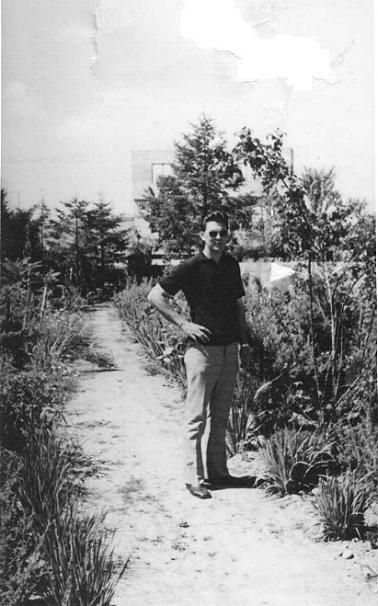
Carl Woida (1971) |
Click on Photo to Enlarge
(Courtesy Carl Woida)
He continued, "Also remember a lone Aviation Warrant bringing his UH-1, leaking hydraulic oil badly, in to the Launcher Helipad in a snow storm. He & I found a missile part (o-ring) that repaired it nicely and off he went, again in the snow storm. Recently attended a E/4/44 reunion in the Baltimore area of 6 officers that were in Echo Battery, 71-72 (Cpt Wallace, Lt Rokosz, Lt Phillips, Lt Glasgo, Lt Nason, and your truly)."
1972 John Crawford of Boston MA wrote in Mar 2005, "Haven't found any of my old friends (1972-1973) yet, it was an experience that I'll never forget and along with the friendships that could never be repeated - I miss the good old times (the bad long forgotten). Also, if anyone remembers the Jeep with yellow headlights (courtesy from the Vil), that was my jeep. The jeep was "DL" in the motorpool requiring a Distributor, I bought one from the "Vil" and made a deal with Motorpool Sargent to have the jeep assigned to only me (otherwise I would take back the distributor). I had the jeep repainted (in the Vil) for which it became the best looking vehicle (with yellow headlights) in the Camp. The "XO" loved the jeep so much, he made me his "driver". I held many positions during the 13 months, short and long range Acq radar operator, Post 4 guard, Como station switchboard operator, XO driver , xxxxxmarket king, and a "banker"."
1974 Robert W of Monterey, CA wrote in the guestbook in Nov 2004, "...I was at echo hill 7-74 thru 7-75. I came back to echo hill Feb 77 and trained launching area section crew of katusa soldiers as part of the exchange to korean "ownership" I was the last american section chief of B section.I also had what was probably the last launching area mascot dog named Chingo. I remember you m.p. dog handlers and must admit you have done a great job in doing this website. I went back to the village in 1987 and played tourist. I met a few of the old natives and even visited "water point" temple. I was surprised that now the place is rokaf. I see you used a lot of the pics from what was the last year book of echo hill. I was really stoked to see a pic of sp/5 claudio. We still keep in touch and tell war stories. ... As the old b.c. Marquart would say "BALLS TO THE WALLS" (SITE NOTE: Name most likely "Chingu" meaning "friend".)
Kenneth Wisz continued, "We had 2 sections of conventional h.e. (high explosive) warheads and 1 with the big boomers. (NOTE: "Big boomers" refers to nuclear warheads on the Nike Hercules.) We shipped the big boomers out in early 1975 as we were preparing to turn the sites over to the ROK army in 1976."
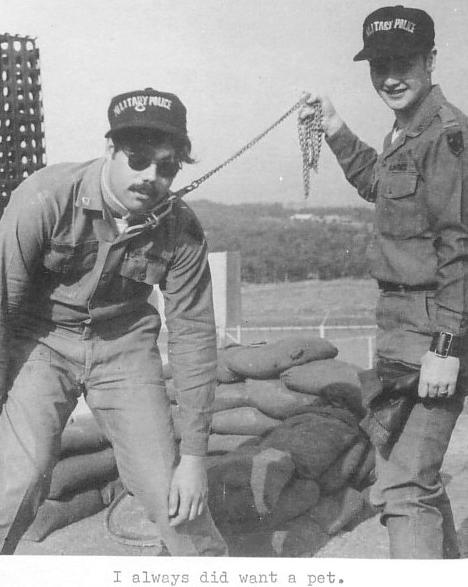
Ken Wisz (Left) and Wayne Dibble (Right)
Click on Photo to Enlarge
As Ken Wisz stated before, "E/2/44 (Echo Battery/2nd Battalion/44th Air Defense Artillery) was the southernmost of the US Army's 6 Nike sites strung out along the west coast of Korea. We were under the operational control of the Air Force HQ at Osan AB." Thus the unit was not formerly in the Kunsan AB organizational chain but only relied on it for supplies. He wrote, "We were the only Nike battery that got most of our logistical support from Kunsan -- food, medical, px , pojee, etc. The others got theirs from Camp Humphreys up at Pyongtaek."
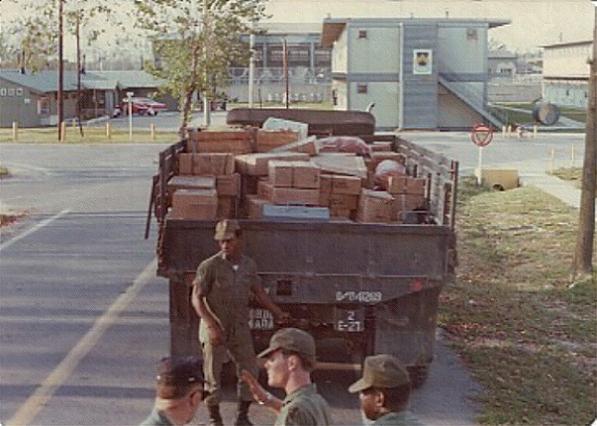
K-8 Food Run |
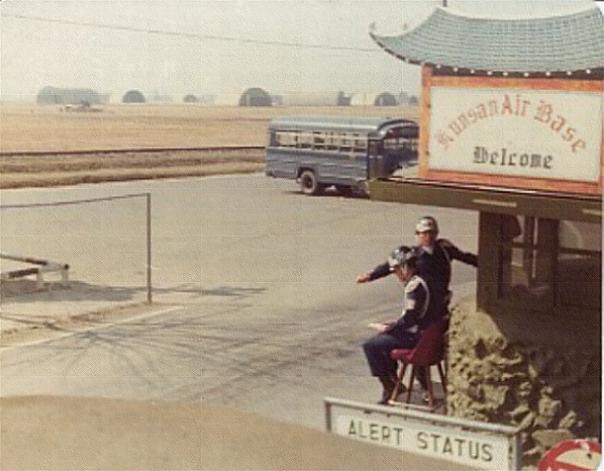
K-8 Main Gate |
Kunsan Air Base (K-8) Food Run
Click on Thumbnail to Enlarge
(Courtesy Ken Wisz) |
Tom Kuzmik who was at Camp Echo Hill with Ken Wisz in 1974-1975 put the experience of life at Camp Echo Hill in perspective. He wrote, "It was a strange place to spend a lifetime..."
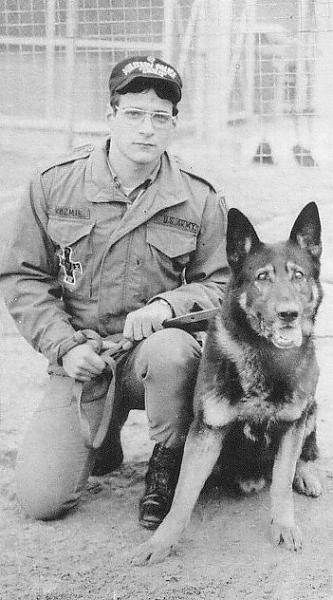
Tom Kuzmik (95B20R3P5)
with the infamous Eric (42M4)
Click on Photo to Enlarge
1975 Ronald V. Kohsman of Westerville, OH wrote in the guestbook in May 2005, "Served at Camp Echoe from Dec 75 until Jan 77. While there, the number of American personal kept decreasing as members rotated out with no replacements. The highlite of my tour at Echo Hill was the funeral and burial of the daughter of one of our military members in the hill just outside the maingate."
Nike Site at Kimje: Kenneth wrote that he'd been trying to locate his old site, but that it seems to have been abandoned. He wrote, "I've been trying to find someone in the area of Kimje to check out the old E btry site. I had been in email contact with a Korean woman in Kimje who said she had heard it was closed down by the ROKs also." (SITE NOTE: Kalani O'Sullivan drove to Kimje to Hwangsan and the Nike site was still operational. The Nikes were turned over to the ROKAF in 1991 and was still in operation in 2003...though the site was reported to be soon to be deactivated. The aged and malfunctioning Nikes were still on the original launch pads as Kalani found out when he approached the gates of the launch pad area to be greeted by ROKAF security guards. The radar site above the temple was still operating as indicated by the airconditioners running for the radar. The ROKAF were still fiddling with a SAM-X project to replace these aged weapons systems and trying to negotiate the purchase of a used PAC-2 system from Germany -- though it seemed to be a hall of mirrors as the ROK kept stalling as they are under the "umbrella" of the USFK PAC-3 batteries.)
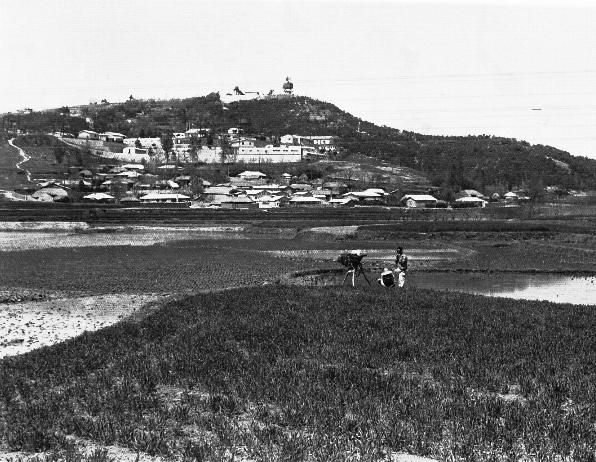
E Battery IFC and Admin area
(Click on photo to enlarge)
(Courtesy Ken Wisz)
"E btry was located about 2 miles east of the railway in the village of Hwangsan which has since been incorporated into the Kimje city limits. The IFC and admin areas were located on the big hill where Moon-soo-sa temple is located.there was a limestone quarry on the west side of the hill. The launcher area was located about a mile southeast of the admin/IFC hill on a lower hill. The site was in the rice paddies of the Honam Plain to allow for a safe impact area for the rocket boosters to fall in after separation from the warhead."
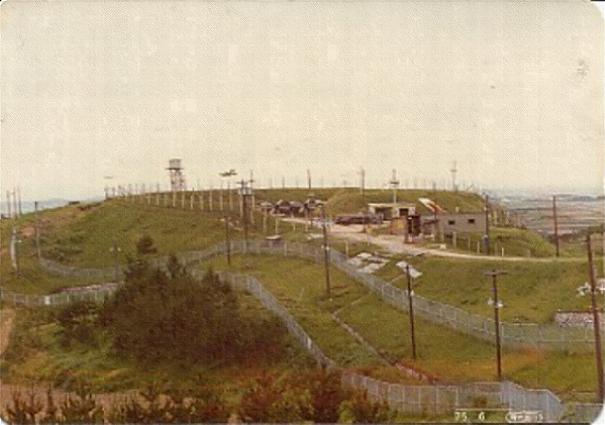
Charlie Section |

Helipad Alpha section
Day Nuke Warheads
Removed |

CH-47 Helicopter |
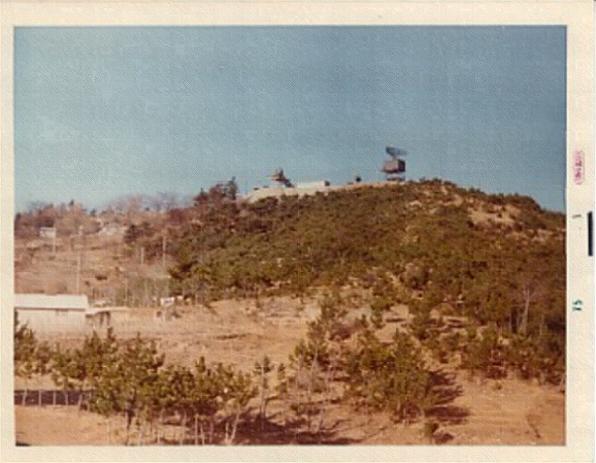
IFC |
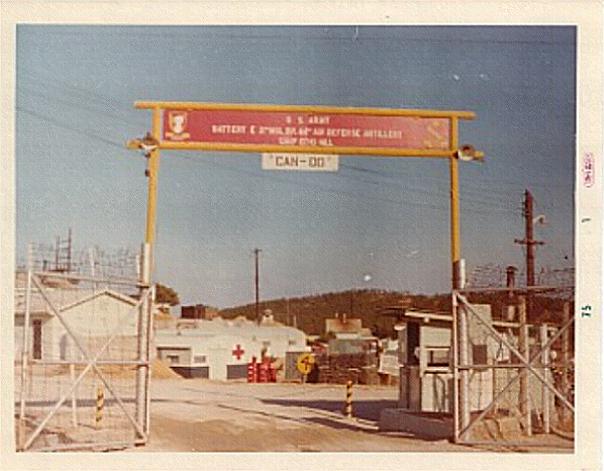
Main Gate |

E-Battery Sign |
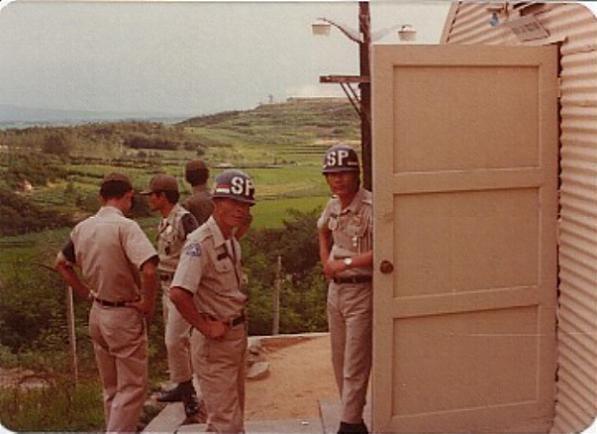
SPs: Bravo Section on hill in bkgnd |
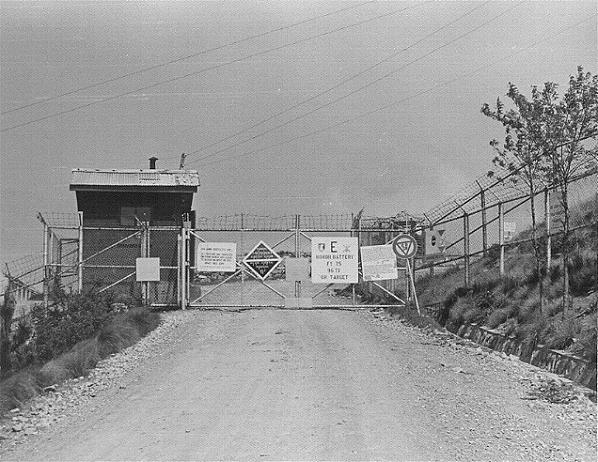
IFC Gate Shack |
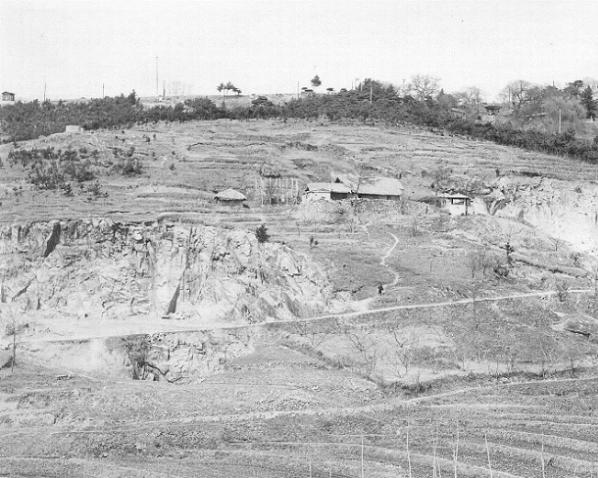
Quarry & IFC Gate Shack |
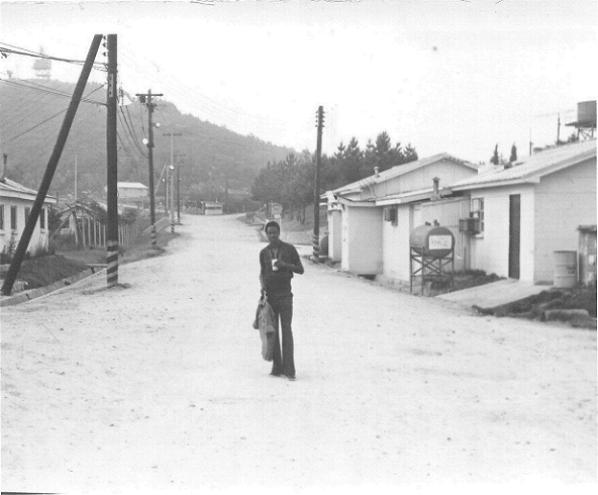
Spec4 Smith:
Back Gate Admin area to IFC |
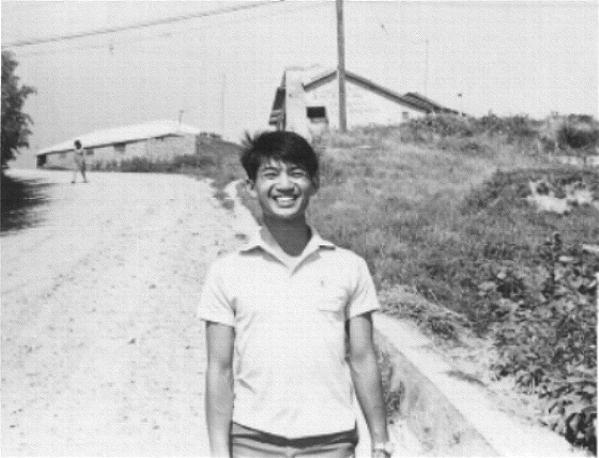
Spec5 Claudio:
Road up to Admin area |
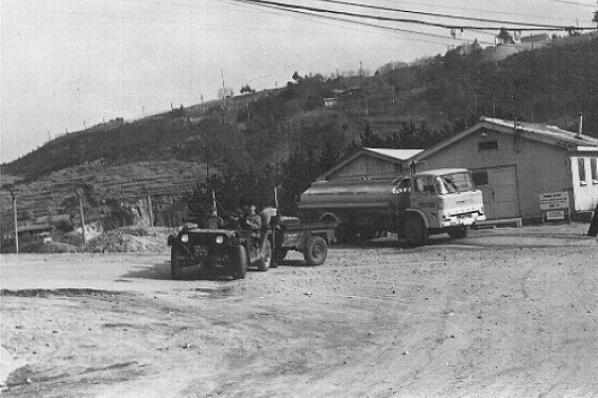
Water Plant |

Looking west toward
Kimje from Motor Pool |
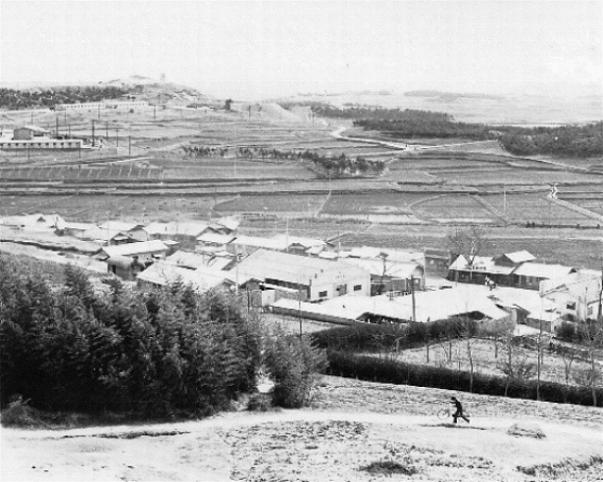
Ville: Looking down from Motor Pool |
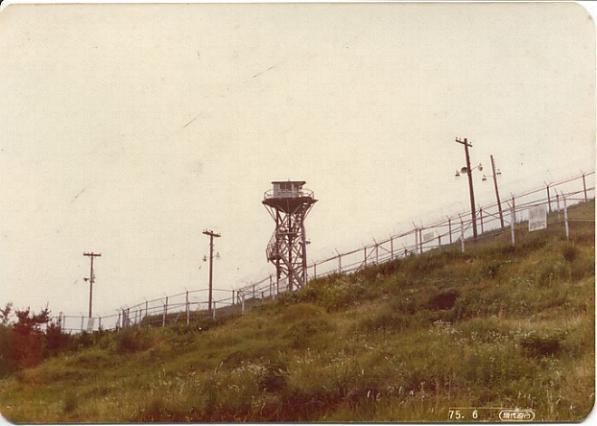
Tower #8 Bravo Section |
Camp Echo Hill (1975)
(Courtesy Ken Wisz)
Click on Thumbnails to Enlarge
Because of the requirements for the IFC (Integrated Fire Control) area, the IFC had to be on a hill (or mountain top) for best practical views of targets. The raised radome to place the radar above the surrounding vegetation would have been easily visible. It had a ready room, sleeping area, rest area, drinking water and latrine facilities. Of course, it was surrounded by a security fence and probably guarded by ROK Army. Because it was probably located on a mountain or hill top, it most likely had its own Auxiliary Power Unit that operated 24-hours a day. (NOTE: In the 1970s, the commercial power in Korea was stable, but very "dirty" and subject to great fluctuations in voltage during peak hours.)

E Battery General area
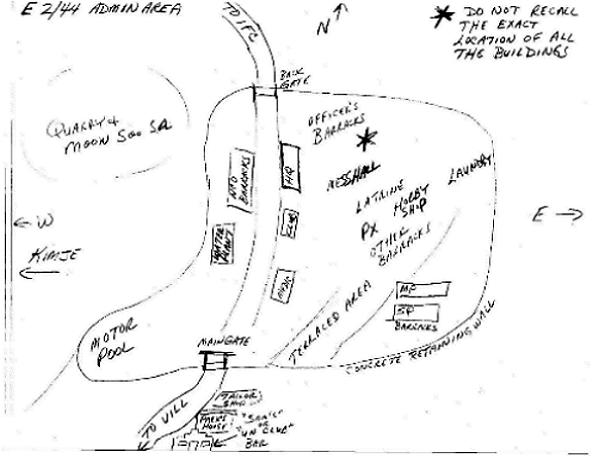
E Battery Admin area
NOTE: The temple is above
the road at a higher
elevation than the Admin area.

E Battery Launcher area
(CLICK ON MAPS TO ENLARGE)
Prior to finding out about the Camp Echo Hill site in Kimje, the only ROKAF Nike missile battery we were aware of was up in Sochon -- about 22km north of Kunsan in Chungchong-do Province. In fact, they had a real flakey-looking imitation of a Nike erected on the side of the road as you enter the old town of Sochon. We do not know if the Nike unit is still there. The ROK Army AAA base also used to be the home of the USAF "Magnum" auxiliary ammo storage area up till about 1989.
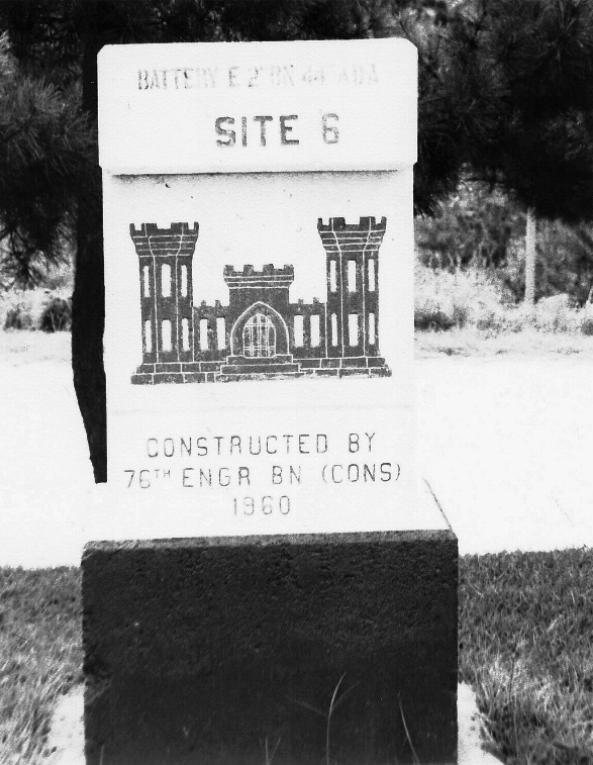
Site 6 Marker
76th Eng Bn (Cons) (1960)
(Click on photo to enlarge)
(Courtesy Ken Wisz)
Kenneth later stated, "The official name for E Battery was "Camp Echo Hill" and there was an upright concrete marker from the Army Corp of Engineers with the Corps emblem and the words "site 6" located in the admin area. The Kimje city limits used to end at the railway line that ran north and south thru Kimje. The road to E Battery ran east from Kimje thru the ville of Hwangsan Samoul and continued on to the city of Chonju (or Jeonju) and the Kumsan-sa temples. If you can find the Moon-soo-sa temple you're at the site of the admin area and IFC (Integrated Fire Control) hill. IFC was at the very top of the hill and the admin area was terraced on a lower level sort of on the south east side of the hill. The launcher area and helipad was on a lower hill about a mile southeast of the admin area on the other side of the road."

Chogi A-frame
Click on photo to enlarge
(Courtesy Jerry Greely)

Looking at ABAR |

View from ABAR looking down on the hill
|

View from FTOH from top of the hill (looking at the small village on the way to Kimje)
|
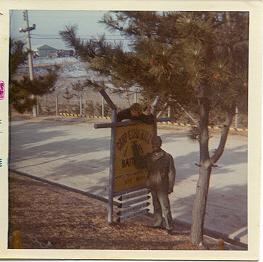
Echo Sign: "I'm the one on top of the sign, we were on our way home."
|

Backyard scene from rear of compound |
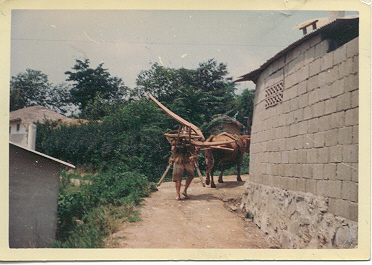
Backyard scene from rear of compound |
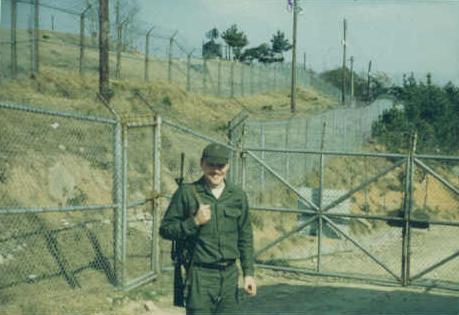
Post 4 |
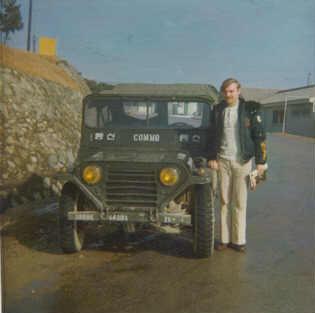
My Jeep |
Camp Echo Hill (1973)
(Courtesy John Crawford)
Click on Thumbnails to Enlarge
Hwangsan Village -- Camp Echo Hill Village: Jerry Greely mentioned that the villagers were at times authorized to use the IFC hill top for celebrations or religious ceremonies. This appears to have been a tradition started from the earliest period of the camp. Jerry Greely who was at Camp Echo Hill in 1965 sent the following photos and wrote, "Echo Battery village residents celebrating Korean holiday on helipad outside IFC."
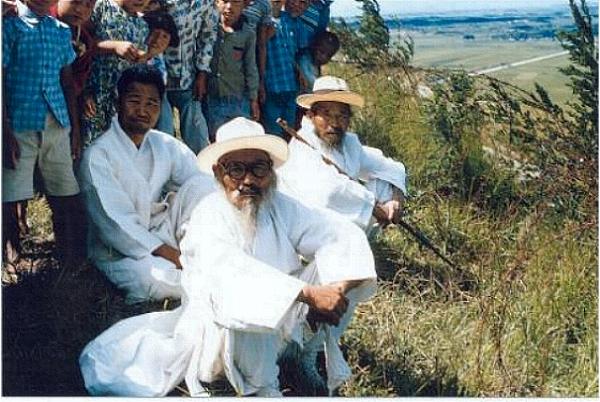
Village Celebration at Helipad |

Village Celebration at Helipad |
Ken Wisz later wrote, "If you find the old ville look for some people named Paek. We rented our hooches from them. A son named Paek Chung Chul was our interpreter/ translator/ procurer. I often wonder what happened to all them folks who worked at the battery after we left. There wasn't much there other than rice farming back then and them farmers worked there asses off from dawn to dusk and didn't have much to show for it."
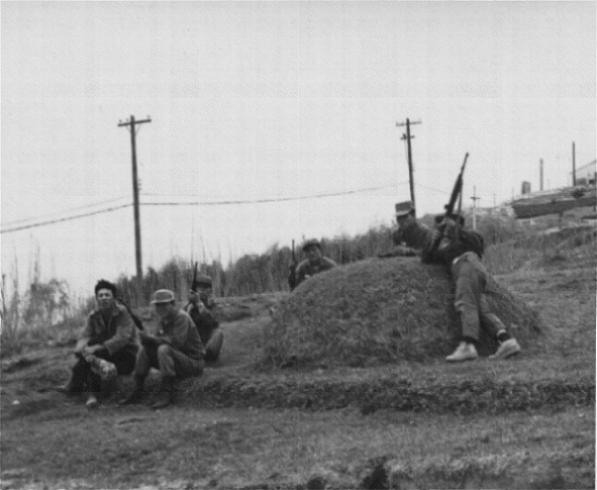
Home Guard (1975)
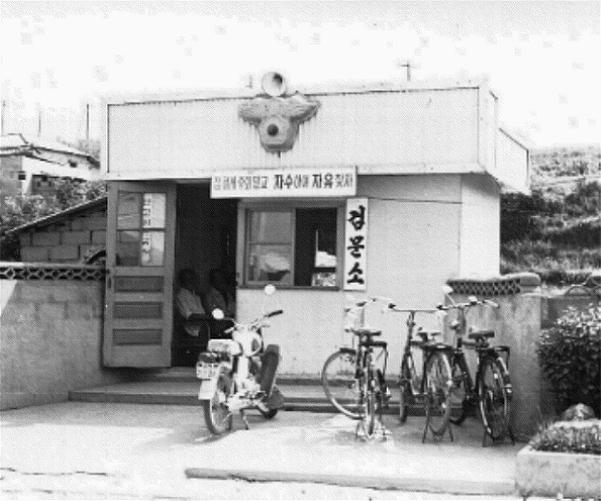
Police Box in the Village
(Click on photo to enlarge)
(Courtesy Ken Wisz)
Ken Wisz wrote, "Also, Echo battery used to support an orphanage in Kimje called the Keum-san-seolin Middle School run by a Mr. Cho Young-cho. A CWO Joseph Pisz was in charge of making sure we donated a buck or two every payday before we left the paymaster and headed down to the ville to spend it on OB Mekju, Oscar champagne, Baik Wha Soju and the business women. The orphans came to the admin area of the battery in the summer and cut weeds, then they were fed in the mess hall and given lemonade to drink in exchange for their labor. I don't suppose they got to eat meat very often in the orphanage. The Mayor of Kimje was a frequent visitor to our battery. His name was Mr. Yi Kil Yun. The battery interpreter was Mr. Kim Ung Muk. Maybe one of them is still around."
Orphans at Camp Echo Hill
Click on Photo to Enlarge
(Courtesy Ken Wisz)
Ken Wisz wrote, "Here's the landmark photos. I believe that the Oasis UN Club should still be there. As you can see it was a substantial structure (biggest & best constructed in the ville). As you entered the ville from Kimje you would pass the Giant club (on the right) continue to where the access road to the admin area intersected on the left. The oasis club would be on the right as you look up the access road. The road itself was quite wide to allow tractor trailers to enter the Admin area. The Paek family lived in the hooch right above the Oasis Club." He continued, "I lived in a newer hooch (built in early 1975) behind the family hooch." He added, "The access road went up the hill curved to the right a bit, then back to the left and flattened out at the entrance to the admin area."
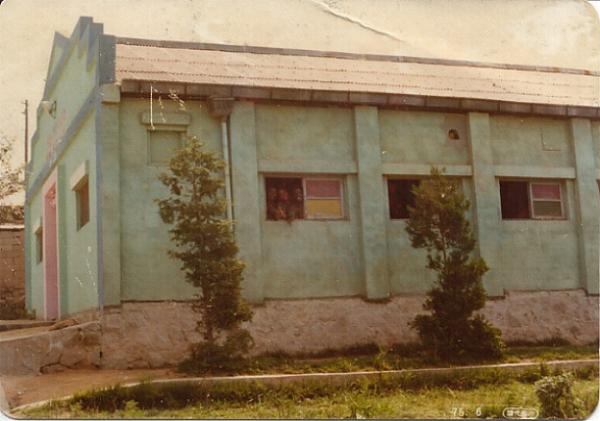
Oasis UN Club |
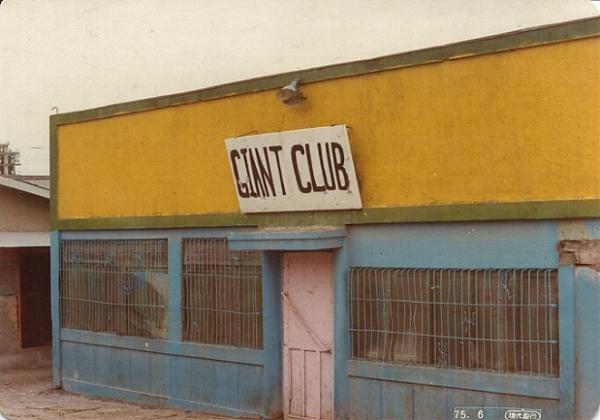
Giant Club |
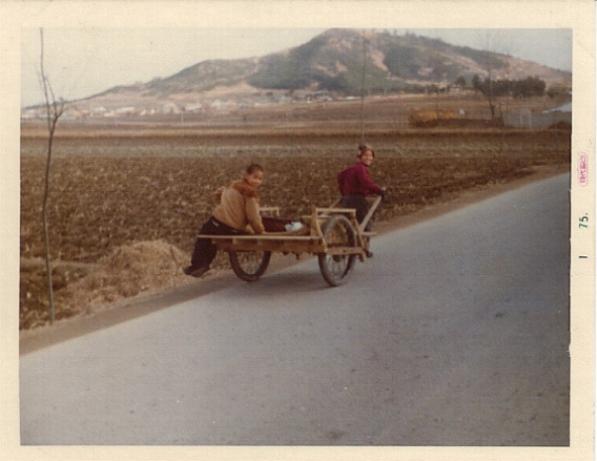
Kimje Road Looking East | 
Kimje Road Looking East |
Ville (1975)
(Courtesy Ken Wisz)
Click on Thumbnails to Enlarge
Nike Phaseout: The "big boomers" (nuclear warheads) were used for the complete destruction of enemy bomber formations. As a result, most Nike sites had a fallout shelter to protect their troops from the fallout of its own blast. The removal of nuclear warheads from Korea in 1974 seems to fit in with the change in the PACAF Single Integrated Operational Plan (SIOP) Quick Reaction Alert commitment that occurred in late 1974. With the Salt Treaty, there were great efforts to shut down the nuclear offensive threat posed by the nuclear alerts in Korea -- and as well as the nuclear-tipped Nike missiles. When the 8th TFW arrived in Sept 1974, the nuclear alert commitment was switched to the 18th TFW at Kadena, Okinawa in October 1974.
By 1974, there had been a widespread closing of Nike sites. The final "blow" came when the 1974 SALT II treaty was signed by the U.S. which forbade operational Nike type equipment in the U.S. (among many other types of equipment). The U.S. moved quickly to disable remaining operational Nike missile launchers by physically cutting the hydraulically operated missile erecting shafts. A few launchers were retained intact for training and display purposes.
Besides the Salt Treaty, there seems to be a variety of other reasons for the reduction in Nike deployments from 1974 forward: (1). The evident shift of emphasis by the USSR from manned bombers to ballistic missiles (2). The apparent ability of USSR missiles to strike any place. (3). The inability of Nike (or any other system) to stop this missile threat (4). The very high cost in man-power and equipment to maintain the Nike anti-aircraft capability, when the aircraft threat was being replaced by the missile threat.
With no Nike sites in the U.S., there was no reason to retain remote sites in Korea. As the equipment was suddenly obsolete, arrangements were made for the transfer of the Nike Hercules to the RoK Army as a surface-to-air defense. Camp Echo Hill was turned over to the ROK Army with equipment in place on April 1977. Richard L. Ehrenreich, Captain, Battery Commander, wrote on Nike People, "First fire unit in the Bn to turn site and equipment over to ROKAADCOM in April, 1977, one week after firing out with a KATUSA crew (and an American BCO -- me!) at Sea Range. Went to Bn HQ, on staff to LTC George Evans, and assisted with turnover of two of the five remaining batteries."
Article of Nike Missile Transfers (1975)
Click on article to enlarge
(Courtesy Ken Wisz)
However, these Nike Hercules missiles turned over to the ROK army became a controversy when the surface-to-air missile was modified without U.S. consent for ground attack. Later, someone stated that there was no "modification" and that the Nike had this capability all along. The only problem was that the Koreans had signed a treaty with the U.S. that said they wouldn't. That was the problem. The U.S. did NOT want to give the South Koreans an offensive capability.
It is interesting to note that the RoK Army is still using these same outdated weapons that were turned over to them years ago. In 1999 an Honest John missile was inadvertantly launched in Inchon. As a result, South Korea in 2000 unilaterally declared that it was developing its own defense missiles -- over the heated protests of the U.S. The U.S. still does NOT want Korea to have an offensive missile capability, but in the past three years the USFK has started to change its philosophy. It now preaches to "take the fight north." This change in strategy would require the South Koreans have an offensive capability. As a result, the ROK has been able to develop and indigenous cruise missile capable of reaching North Korea.
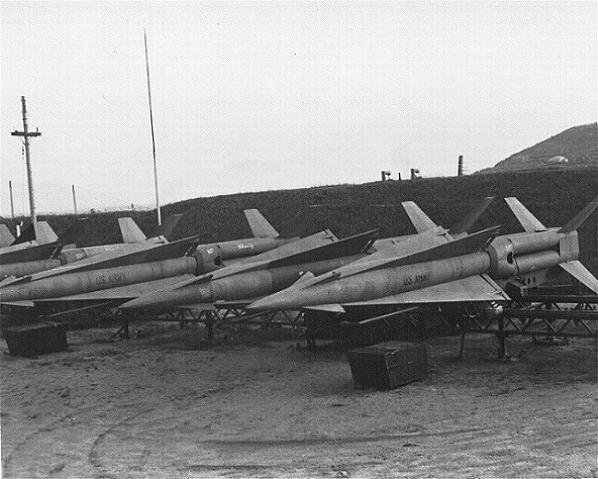
Nike-Hercules at Camp Echo Hill -- Outside Storage (1975)
(Click on photo to enlarge)
(Courtesy Ken Wisz)
Equipment Specifications: The Nike Hercules was a more reliable version of the older Nike Ajax. It resembled a cone with four cylinders shoved up its behind. The Nike Hercules had a 75 mile range according to the Redstone Arsenal. Targets as high as 25 miles could be downed. Its altitude was 150,000 feet. The speed was Mach 3.65. The Improved Hercules added measures against jamming. The Nike Hercules missile was a more powerful model. It was faster and had more than three times the range (more than 75 miles) protecting more than nine times the area with nuclear (as well as conventional) warheads.
The added Nike Hercules Acquisition Radar (HIPAR) had a range of over 150 miles. The Nike Ajax Acquisition Radar (LOPAR) was retained for added flexibility. The added Target Ranging Radar (TRR) increased resistance to jamming.
The missile was powered by solid propellants. It was manufactured by Douglas (now Boeing) Aircraft Company in Santa Monica, CA. Booster propulsion came from Hercules Powder Company and the sustainer was from Thiokol Chemical Company. Guidance came from Western Electric Company. Either conventional fragmentation or nuclear warheads were carried. Nuclear warheads were designed to obliterate entire formations of bombers. Dimensions were 41 feet in length and 31.5 inches in diameter. Wingspan was 6 feet, 2 inches. Guidance was command-based; that is, the radars tracked the missile and the target and by using computers arranged a bumpy relationship with missile and target by vectoring in the missile.
NOTE: For further information, go to Ed Thelen's Nike Missile Web Site which is the definitive collection of materials on Nike Missiles.
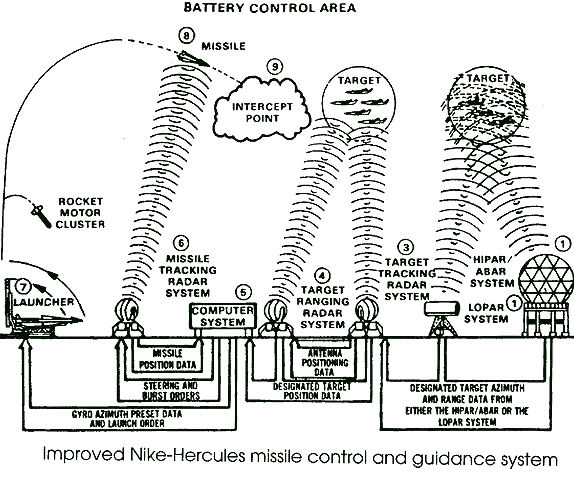 Figure from FM 44-1-2 ADA Reference Handbook, 15 June 1984,
Figure from FM 44-1-2 ADA Reference Handbook, 15 June 1984,
as found on page 20 of "Rings of Supersonic Steel".
Click on image to enlarge
From Ed Thelen's Nike Missile Web Site
An excellent resource to view the Nike hardware is at Nike Hercules Missile made by Ronald Erkelens. It states, "On these 8 pages you can find information regarding Missile/Booster, Launcher, LCI, LCC and SCG.
No doubt, the info isn't complete to the last detail, but it gives a rough idea of what's going on on the Launching Area." All information and drawings from the original course-book "Lessenbundel Cursus SD 139 Lancering Nike" by the Royal Dutch Airforce. (Provided by Erik Jan Mauritz)
Missile Specifications and Performance Data
Launcher Control Indicator (LCI)
Launcher Base Frame
Launcher Erecting Beam
Launcher Erecting Assembly
Launching and Handling Rail
Launching Control Console (LCC)
Section Control Group (SCG)
Click HERE to view a video clip of a Nike Launch (Audio Streaming File (asf)).
Booster Markings:
Left: 1950s-1960s; Right: 1960s-1970s
Click on image to Enlarge
Another superb resource is Redstone Nike Missile Site. There are a lot of downloadable video/information files at this site.
Nike Hercules* (SAM-N-25) (MIM-14/14A/14B)
Summary
As the Nike Ajax system underwent testing during the early 1950s, the Army became concerned that the missile was incapable of stopping a massed Soviet air attack. To enhance the missile’s capabilities, the Army explored the feasibility of equipping Ajax with a nuclear warhead, but when that proved impractical, in July 1953 the service authorized development of a second generation surface-to-air missile, the Nike Hercules. As with Nike Ajax, Western Electric was the primary contractor with Bell Telephone Laboratories providing the guidance systems and Douglas Aircraft serving as the major subcontractor for the airframe.
In 1958, 5 years after the Army received approval to design and build the system. Nike Hercules stood ready to deploy from converted Nike Ajax batteries located in the New York, Philadelphia, and Chicago defense areas. However, as Nike Hercules batteries became operational, the bitter feud between the Army and Air Force over control of the nation’s air defense missile force flared anew. The Air Force opposed Nike Hercules, claiming that the Army missile duplicated the capabilities of the soon-to-be-deployed BOMARC. Eventually, both of the competing missiles systems were deployed, but the Nike Hercules would be fielded in far greater numbers over the next 6 years.
During the course of the Cold War, the Army deployed 145 Nike Hercules batteries. Of that number, 35 were built exclusively for the new missile and 110 were converted Nike Ajax installations. With the exception of batteries in Alaska and Florida that stayed active until the late 1970s, by 1975 all Nike Hercules sites had been deactivated.
Technical Specifications
Length: 41 feet
Diameter: 31.5 inches
Wingspan: 6 feet, 2 inches
Weight: 10.710 pounds
Booster fuel: Solid propellant
Missile fuel: Solid propellant
Range: Over 75 miles
Speed: Mach 3.65 2,707 mph
Altitude: Up to 150,000 feet
Guidance: Command by electronic computer and radar
Warhead: High-Explosive fragmentation or nuclear
Contractors
Airframe: Douglas Aircraft Company Santa Monica, California
Propulsion: Booster: Hercules Powder Company Radford Arsenal, Virginia
Sustainer: Thiokol Chemical Corporation Longhorn Division, Marshall, Texas
Guidance: Western Electric Company New York
System Operation
Nike Hercules was designed to use the supporting components of the Nike Ajax system. To engage hostile targets, missilemen followed procedures similar to those used with the Nike Ajax.
Because of the increased capability of the system, there were some additions to the ground equipment. For example, a High-Powered Acquisition Radar (HIPAR) was installed to track targets at greater range. Alternate Battery Radars (ABARs) were also installed as backup units. In addition, a Target Ranging Radar was added to counter enemy radar jamming attempts.
"Missile Master" or ‘BIRDIE" command and control systems were installed at Army Air Defense Command Posts to ensure a coordinated defense against attacking aircraft. Despite the data automation, Missile Master was still a labor-intensive system that eventually became over-capable because the increased range of Nike Hercules reduced the number of batteries that needed to be coordinated. "Missile Mentor," a solid-state system costing one tenth of Missile Master, arrived as a replacement system in the mid-1960s.
In March 1952, due to limitations of the soon-to-be-deployed Nike Ajax system (including the inability to discern individual bombers within a densely-packed flying formation), the Bureau of Ordnance recommended a study of the feasibility of equipping Nike Ajax with a nuclear warhead. Two months later, the Chief of Ordnance asked Bell Telephone Laboratories (BTL) to examine the feasibility of a nuclear Nike Ajax using the current ground system. After consulting with Picatinny Arsenal and Sandia Laboratories, BTL recommended either fitting an XW-9 warhead into the Nike Ajax or building a wider missile to carry the more potent XW-7 warhead.
In August, the Chief of Ordnance approved an engineering study to investigate the latter option with the objective of fielding a weapon quickly at minimum cost. As a result of this study, in December the Deputy Chief of Plans and Research approved plans for the follow-on project.
Two months later, in February 1953, the Army asked BTL to develop detailed proposals for a Nike "B" or Hercules. A month later, Bell and Douglas Aircraft Company representatives outlined three ground guidance systems for missile designs varying in range from 25 to 50 miles. Longer range missiles would require major revisions to facilities currently being constructed for the Nike Ajax. Soon thereafter, Nike "B" received approval from the Joint Chiefs of Staff with a 1A priority.
On July 16, 1953, the Secretary of the Army formally established the Nike "B" program with the objective of obtaining a weapon that could intercept aircraft flying at 1.000 miles per hour, at an altitude of 60,000 feet, and a horizontal range of 50,000 yards.
Western Electric, BTL, and Douglas began the research and development phase and by 1955 began conducting test firings at White Sands Proving Ground, New Mexico. To build the new missile, the Nike Hercules design team simply took the components of the Ajax missile and multiplied by four. Four solid booster rockets were strapped together to push the missile into flight. Once the booster rockets fell away, four liquid-propellant driven engines would carry the warhead to the target. Unfortunately, this design, dependent on multiple systems, hindered reliability. Of the first 20 flights, 12 had to be terminated due to malfunctions. On September 30, 1955, tragedy struck at White Sands when a liquid-fueled engine undergoing static testing exploded with such force that the protective bunker sustained damage. This explosion killed one worker and injured five others. This incident convinced designers to consider a solid propellant engine for the sustainer missile.
Testing continued. October 31, 1956, marked the first successful Nike Hercules intercept of a drone aircraft. On March 13, 1957, the first flight test using the new solid propellant sustainer engine was conducted at White Sands.
During the following summer, a test called Operation Snodgrass conducted at Eglin Air Force Base, Florida, demonstrated the ability of the missile to single out a target within a formation of aircraft. By this time, the first of several Nike Ajax sites had been converted to accept the new missile.
Meanwhile, work was well under way to improve acquisition and tracking radar capabilities that would further exploit the capabilities of the Nike Hercules. The Army pushed ahead with development of a system dubbed the "Improved Hercules" that incorporated three significant improvements. First, the Improved Hercules sites were to receive the HIPAR L-band acquisition radar to detect high-speed, non-ballistic targets. The other two improvements included improving the existing Target Tracking Radar and adding a Target Ranging Radar operating on a wide-ranging frequency band designed to foil attempts at electronic counter-measures.
The potential of the Improved Hercules was demonstrated on June 3. 1960, when a Nike Hercules missile scored a direct hit on a Corporal missile in the sky over White Sands. Beginning in June 1961, Army Air Defense Command (ARADCOM) began phasing in Improved Hercules to selected batteries.
Basing Strategy
As previously mentioned, the Nike Hercules was designed to use existing Nike Ajax facilities. With the greater range of the Nike Hercules allowing for wider area coverage, several Nike Ajax batteries could be permanently deactivated. In retrospect, air defense planners lamented the backfitting of Nike Hercules missiles into existing sites close to areas that were vulnerable to the new threat of Soviet ICBMs. In addition, sites located further away from target areas were desirable due to the nuclear warheads carried by the missile.
Fortunately, not all strategic locations faced this situation. In the late 1950s early 1960s, surface-to-air missile batteries were placed for the first time around such cities as St. Louis and Kansas City and around several Strategic Air Command (SAC) bomber bases. Unlike the older sites, these batteries were placed in locations that optimized the missiles’ range and minimized the warhead damage. Nike Hercules batteries at SAC bases and in Hawaii were installed in an outdoor configuration. In Alaska, a unique above-ground shelter configuration was provided for batteries guarding Anchorage and Fairbanks.
Local Corps of Engineer Districts supervised the conversion of Nike Ajax batteries and the construction of new Nike Hercules batteries.
Nike Hercules Deployment
Nike Hercules first entered service on June 30, 1958, at batteries located near New York. Philadelphia, and Chicago. The missiles remained deployed around strategically important areas within the continental United States until 1974. The Alaskan sites were deactivated in 1978 and Florida sites stood down during the following year. Although the missile left the U.S. inventory, other nations maintained the missiles in their inventories into the early 1990s and sent their soldiers to the United States to conduct live-fire exercises at Fort Bliss, Texas.
Site Configuration
As previously mentioned, converted sites received new radars and underwent modifications so the new missiles could be serviced and stored.
Because of the larger size of the Nike Hercules, an underground magazine’s capacity was reduced to eight missiles. Thus, storage racks, launcher rails, and elevators underwent modification to accept the larger missiles. Two additional features that readily distinguished newly converted sites were the double fence and the kennels housing dogs that patrolled the perimeter between the two fences.
New sites, located away from populated areas did not have to be confined in acreage. Consequently, these batteries were all above ground with missile storage and maintenance facilities located behind earthen berms.
Not all sites received the complete Improved Hercules package. HIPAR radars were denied to some sites due to geographical constraints and/or to avoid duplication of radars located at adjacent sites.
*From To Defend and Deter: The Legacy of the United States Cold War Missile Program, John C. Lonnquest and David F. Winkler, USACERL Special Report 97/01, November 1996. Cleared for unlimited public release by the U.S. Army Construction Engineering Research Laboratories, Champaign, IL. Printed by the Defense Publishing Service, Rock Island, IL.
For comments or inputs, contact
Kalani O'Sullivan
.
NOTICE/DISCLAIMER: The content of this page is unofficial and the views and
opinions expressed do not necessarily reflect those of anyone associated with
this page or any of those linked from this site. All opinions are those of the
writer and are intended for entertainment purposes only. Links to other web
pages are provided for convenience and do not, in any way, constitute an
endorsement of the linked pages or any commercial or private issues or products
presented there. None of this site has been endorsed by the DOD, the United States Army, the USFK,
the Republic of Korea or Mickey Mouse. All links are publicly
accessible through the world-wide web. If there is any discrepancy between
eye-witness accounts and OFFICIAL DOD records, this site opts to lend credence
to the eye-witness views.

|
|
|